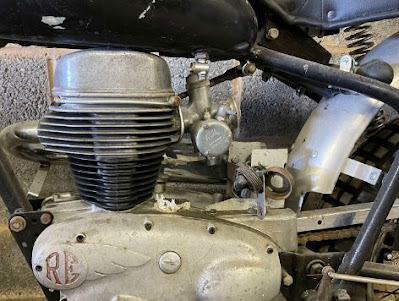 |
| Royal Enfield trials motorcycle has a horn, but it's hidden. |
Bulb horns. I love 'em. Just for fun, of course. My Royal Enfield Bullet has the usual electric horn. (I never use it; no one pays any attention anyway.)
You know what is even more fun than just the whimsical idea of a bulb horn? It's this: finding a place to put it.
Well, on the handlebars, of course, you'd think. Back in the day, that's where a bulb horn or Klaxon would show up.
But not always.
 |
| Who would put a bulb horn under a motorcycle seat? |
For years I've noticed that old photos of motorcycles participating in trials events in Britain show bulb horns mounted in the oddest ways.
Facing down with the bulb up. Facing down mounted nearly out of reach on the rear downtube.
And, just recently, an auction site showed a Royal Enfield trials motorcycle with the bulb horn mounted nearly out of sight, under the seat.
What's going on?
Well, obviously, some government or sanctioning body required that a horn be present, but the competitor is going to choose the lightest possible horn, and is going to put it somewhere it won't get in the way; as it might, on the handlebars.
Bulb horns are lighter than electrics, and the creative locations can be as varied as your creativity and the length of your reach.
OK. But why a horn, when these competition motorcycles run without even lights?
 |
| Here's a full look at the 1957 Royal Enfield Crusader trials motorcycle. |
In Britain, vehicle safety standards were set, starting in 1960, by the Ministry of Transport. And even though that agency was absorbed by the Department for Transport, safety inspection stickers are still called MOTs.
It turns out that in Britain it is (or at least it was) possible to legally ride a motorcycle without lights, if the motorcycle is used only during the day. As would be the case with a motorcycle meant only for trials events.
But the need for a horn exists both day and night. So you have to have a horn. Perfectly logical, if completely crackers.
The Audible warning (horn) rules and inspection for motorcycle MOT tests state:
An audible warning must be loud enough to be heard by other road users.
It must not be:
gong
bell
siren
more than one tone
Motorcycles first used on or after 1 August 1973 must emit a continuous or uniform sound that is not harsh or grating.
Motorcycles first used before 1 August 1973 can have a bulb horn as the audible warning.
I'm grateful to the denizens of the PistonHeads forum for that link.
The forum has an amusing discussion of the matter. Member Rushjob contributed this:
"Just because it has a daytime MOT doesn't mean it's road legal! The use of motorcycles with minimal lighting was as a result of the tweak to the UK law to allow trials bikes to go on the roads for the ISDT and similar competitions. If you start to dig down into the relevant legislation you see requirements for single seats, off road tyres and suspension travel -- quite interesting stuff."
To which member Tango13 replied "there is no such thing as a daylight MOT." And the discussion was off to the races.
But, regardless, everyone seemed to agree that you gotta have a horn.
Although, really: why NOT a gong?
No comments:
Post a Comment